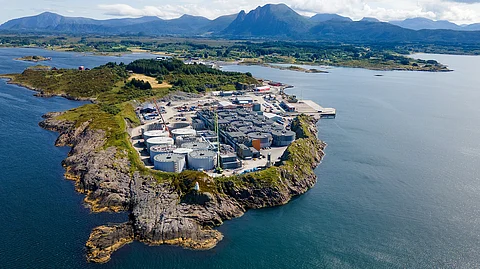

Aerial view of Salmon Evolution's Indre Harøy site near Molde, Norway.
Photo: Salmon Evolution.
Norway's Salmon Evolution has announced its results for the second quarter of 2025, reporting revenues of NOK 91.1 million in the second quarter after harvesting 1,232 tonnes HOG.
The land-based salmon farming company, which operates a hybrid flow-through facility at Indre Harøy near Molde, Norway, said its performance was affected by weak salmon prices and temporarily higher farming costs linked to one-off factors. Farming EBITDA was negative at NOK -13.2 million, while Group EBITDA ended at NOK -25.6 million in the red.
However, the company stated that it maintained “stable operations” during the period, with a fully stocked farm and minimal mortality. Salmon Evolution also reported that its biomass composition had returned to normal, which it said positions it for improved operational key performance indicators and higher harvest weights in the coming months.
The company had previously reported an "all-time high" in underlying biomass production in its operational update for Q2, and reported a standing biomass of 3,043 tonnes LW at the end of the quarter.
“With a strong operational platform at the core we will continue to scale production, harvest and harvest weights,” said CEO Trond Håkon Schaug-Pettersen, announcing the results. He added that the company is “well positioned to capitalize on an expected salmon price recovery in 2026.”
Progress continues at the firm’s Indre Harøy phase two expansion project, which remains on schedule. At the end of June, Salmon Evolution announced it had reached a new milestone in the Phase 2 expansion of its land-based aquaculture facility in Indre Harøy, having completed two new seawater intake pipelines.
The company said it expects its first smolt release in the first quarter of 2026 and its first harvest in the final quarter of the same year.
“Momentum at the construction site remained strong throughout the quarter with installation of both intake pipes being a highlight,” Schaug-Pettersen said. “With Phase 2 we are creating a unique operational platform and the first smolt release is only about 7 months away.”
Salmon Evolution also reported it has strengthened its financial position during the quarter through a new credit facility of up to NOK 250 million and an increase in its overdraft facility of NOK 50 million.
Once the second phase is completed, Salmon Evolution expects to increase its production capacity from its current 7,900 tonnes to 18,000 tonnes per year, with the final phase aiming to reach 36,000 tonnes by 2026.
